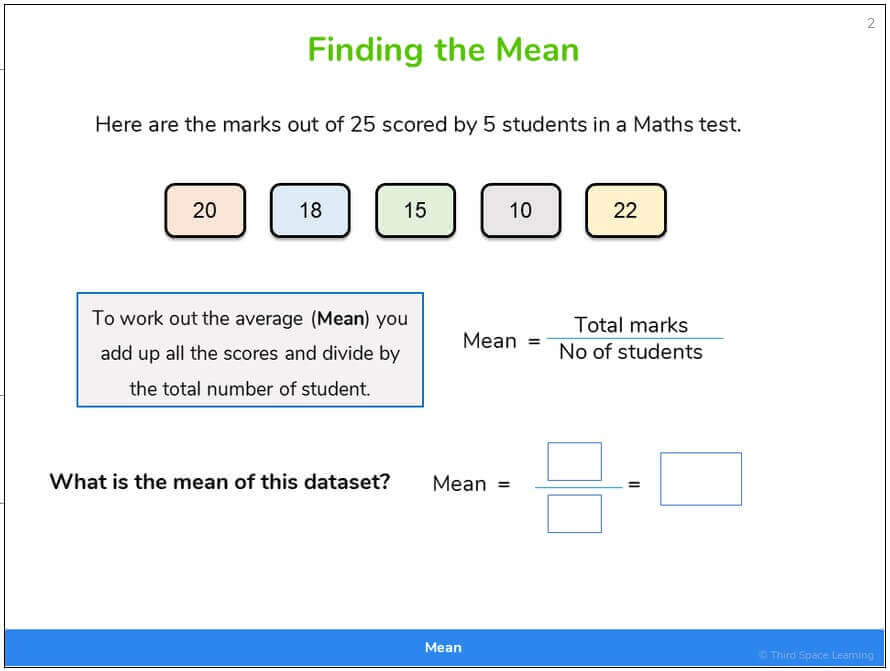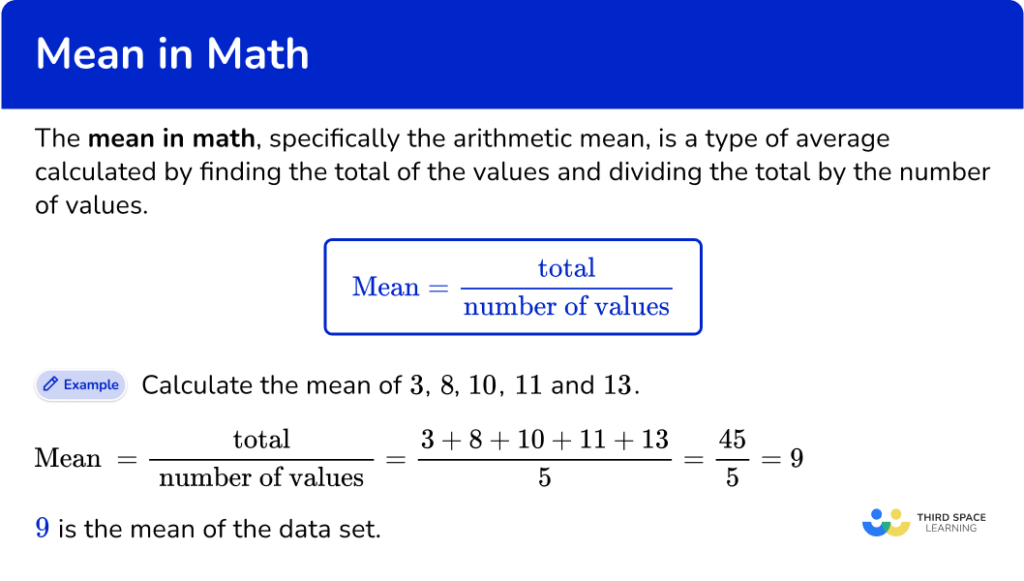Calculate The Mean: Formulas, Examples & Types | Learn Now
Is there a single number that can truly represent the essence of a dataset? The concept of the 'mean,' or average, provides a powerful tool for summarizing and interpreting data, offering a central value that encapsulates the overall trend.
The mean, in its simplest form, is calculated by summing all the values in a dataset and dividing by the total number of values. This fundamental calculation unlocks a world of statistical analysis, allowing us to understand everything from stock market fluctuations to the average height of a population. Understanding the mean is crucial because it is the most common measure of central tendency. It helps us to quickly grasp the 'center' of a dataset and make informed decisions based on the collected information. The mean is not only a fundamental statistical concept but also a versatile tool applicable across various fields, from finance and economics to biology and engineering.
| Feature | Details | | :----------------------- | :------------------------------------------------------------------------------------------------------------------------------------------------------------------------------------------------------------------------------------------ | | Definition | The mean, often referred to as the average, is a measure of central tendency. It's the value obtained by summing all the numbers in a data set and then dividing by the count of those numbers. | | Symbol | x (x with a bar over it) | | Formula | x = (x) / n, where x represents the sum of all data points, and n is the number of data points. | | Types of Means | Arithmetic Mean, Geometric Mean, and Harmonic Mean | | Applications | Used in various fields, including finance (calculating average returns), education (finding average test scores), and healthcare (determining average patient ages). | | Advantages | Easy to calculate and understand. It uses all the values in the data set, providing a comprehensive overview of the dataset. | | Disadvantages | Sensitive to outliers (extreme values) that can skew the result. It may not always be representative of the "typical" value in a skewed distribution. | | Key Terms | Central Tendency, Outliers, Data Set, Summation, Arithmetic Mean, Geometric Mean, Harmonic Mean | | Related Concepts | Median (the middle value), Mode (the most frequent value), Range (the difference between the highest and lowest values). | | Importance | Provides a single value that describes the "center" of a data set, making it easier to compare different datasets and understand trends. Helps identify outliers and understand the distribution of data. | | Limitations | The mean can be misleading if the data set contains extreme values or is not normally distributed. In such cases, the median may be a more appropriate measure of central tendency. | | Real-World Examples | Average salary of employees in an organization, average test scores of a class, the average temperature for a specific month, the average stock price over a period. | | Formula Variations | The formula changes slightly depending on the context and type of mean. For instance, the formula for the geometric mean involves multiplying the numbers in the set and taking the nth root, where n is the number of values in the set. | | Effect of Outliers | Outliers can dramatically affect the mean by pulling it towards the extreme values. This can lead to a distorted view of the data. | | Data Types | The method for finding the mean differs based on the type of data (grouped or ungrouped). | | Where to Learn More | Investopedia - Mean |
- Natalie Portman Sex Scenes Everything You Need To Know Where To Watch
- Uncensored Hentai Best Forced Anime Xxx Videos Watch Now
As a homonym, the word "mean" adds layers of complexity, shifting meaning depending on context. Within mathematics and statistics, "mean" undergoes a transformation, highlighting the need for careful interpretation. Mean is often the arithmetic mean unless another type is specified, such as a geometric or harmonic mean. The arithmetic mean offers a clear, easily understood method for summarizing numerical data, but its value is always influenced by the entire set of data it is meant to summarize.
At its core, the mean provides a single value that represents the 'center' of a set of numbers. This value serves as a benchmark to define various parameters of a given data set. The mean, median, and mode are central measures of tendency used to define the various parameters of a given data set. A mean is a quantity that lies between the extreme values of the set of numbers, which also makes it a measure of central tendency.
There are several different "means", or measures of central tendency, used in mathematics and statistics. These different means are used to study and interpret different types of data, such as average employee salaries in a company, class median age or the number of people who visited a specific point in time. The arithmetic mean, for instance, is the sum of all values divided by the number of values, and is the most common type of mean used. Other types include the geometric and harmonic means, each calculated differently.
- Danielle Gordon Mental Health Eating Disorder Specialist Find Help Today
- Cornelia Brown Frustration Backtoschool Guidelines Change Latest
For example, if you have a dataset of scores, the mean score is calculated by adding all of the scores together and dividing by the total number of scores. The mean, as a measure of central tendency, gives valuable insights into the data being studied. A mean in simple words can be understood as the mathematical average of a set of two or more numbers.
The most common type of mean is the arithmetic mean, which is calculated by summing all the numbers in a data set and dividing the sum by the number of values. The geometric mean is calculated by multiplying all the numbers in a set and then taking the nth root, where n is the number of values. The harmonic mean is calculated by taking the reciprocal of the arithmetic mean of the reciprocals of the numbers. Different types of means are used for different purposes. For instance, the geometric mean is often used to calculate the average growth rate of an investment over time, while the harmonic mean is often used to calculate the average speed of an object over a certain distance.
The formula for calculating the arithmetic mean is: $$\text{mean}=\frac{\text{total}}{\text{number of values}}$$ For example, to calculate the mean of the numbers 3, 8, 10, 11, and 13: $$\text{mean}=\frac{3 + 8 + 10 + 11 + 13}{5} = \frac{45}{5} = 9$$ Therefore, the mean of the given set of numbers is 9.
The mean can be calculated using a simple formula, or an online calculator. You can calculate the mean of a dataset by adding all of the values and dividing the total by the number of values. For instance, you might find the average salary, which is calculated by summing up all salaries, then dividing the total by the number of employees. This simple process is often used to provide a snapshot of a collection of numbers. The mean (average) is a measure of central tendency for a group of values. Unless otherwise specified, mean usually refers to the arithmetic mean, as opposed to the geometric mean or harmonic mean.
Mean, in mathematics, is a quantity that is a value intermediate between those of the extreme members of some set. Several kinds of means exist, and the method of calculating a mean depends upon the relationship known or assumed to govern the other members. This makes understanding different types of mean is critical to proper data interpretation. As data is of two types - grouped and ungrouped - the method of finding the mean is also different depending on the type of data. The mean is often taught and explained through abstract methods as soon as students in 6th grade are capable of manipulating the numbers needed to find the mean or average amount.
Outliers, or extreme values that differ from most values in a data set, can significantly influence the mean. Because the mean uses all values in its calculation, an outlier can dramatically affect the mean, pulling it away from the majority of the values. Understanding outliers and their impact is therefore essential in the interpretation of any mean. Consider a data set of exam scores: 70, 72, 75, 78, and 10. The mean of this dataset is (70+72+75+78+10)/5 = 61. However, without the outlier (10), the mean would be 73.75, a more accurate representation of the class's overall performance. This example illustrates that mean is not the only value, it depends on data sets and requires us to explore the data set.
When we add an outlier to our dataset, the mean shifts to accommodate the additional data point. For example, if we calculate the mean (average) of the dataset: 2, 6, 4, 5, and 8, the mean will be (2+6+4+5+8)/5 = 5. When we add an outlier to this dataset, for instance, a value of 20, the mean shifts, now becoming (2+6+4+5+8+20)/6 = 7.5.
The mean, or average, is a measure of central tendency a representative value around which a data set is centered. Often, it is used to describe the average of a data set. This representative value is a powerful way to understand large datasets without examining all the data points individually. Different measures of central tendency, including the mean, median, and mode, can tell us more about our data. Measures of central tendency are used to study any data, such as the average salary of employees in an organization or average test scores of a class. Therefore, by knowing what is happening when finding the mean of a data set, allows students to understand what is going on in math. The mean, median, and mode are interconnected statistical tools that help in understanding the properties of data sets.
Understanding these different means requires us to determine how to calculate the mean of a dataset using a simple formula or an online calculator. The mean is a powerful statistical tool that simplifies complex datasets, helping users grasp central tendencies and interpret data effectively.



Detail Author:
- Name : Larry Hand
- Username : justus.schuster
- Email : allene.treutel@stanton.com
- Birthdate : 1979-11-08
- Address : 1943 Fritsch Streets Apt. 913 Amiramouth, MN 28510
- Phone : 828-291-0734
- Company : Gerlach-Sanford
- Job : Crushing Grinding Machine Operator
- Bio : Nihil sed fugit ipsum. Voluptas est maxime quo nihil in facilis. Voluptatem veritatis sit sapiente voluptate.
Socials
facebook:
- url : https://facebook.com/kayden.schuppe
- username : kayden.schuppe
- bio : Doloribus esse cupiditate explicabo iste ut.
- followers : 5973
- following : 744
instagram:
- url : https://instagram.com/kayden_real
- username : kayden_real
- bio : Neque delectus voluptatem quas eos earum. Aliquid sit alias omnis voluptatem.
- followers : 1166
- following : 2604
tiktok:
- url : https://tiktok.com/@kayden_schuppe
- username : kayden_schuppe
- bio : Aspernatur ratione est eum necessitatibus repellat.
- followers : 2439
- following : 2791
linkedin:
- url : https://linkedin.com/in/kschuppe
- username : kschuppe
- bio : Aliquid est odio aliquam ut.
- followers : 4403
- following : 2321
twitter:
- url : https://twitter.com/kayden.schuppe
- username : kayden.schuppe
- bio : Velit modi facilis deleniti aut tempore minima. Est deserunt occaecati eum officiis possimus dolor. Quisquam et aspernatur eligendi.
- followers : 3009
- following : 2454